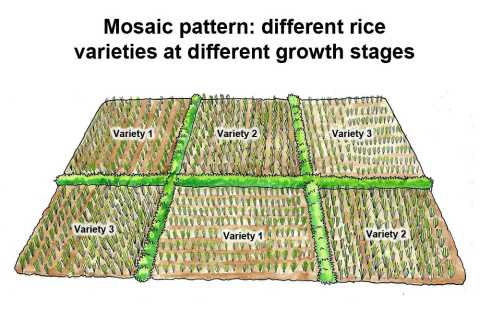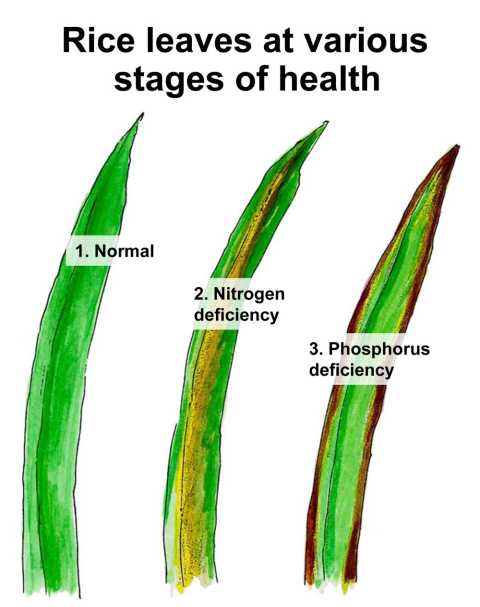Proper weed management
Weeds can reduce rice yields by competing for moisture, nutrients and light. Delays in weeding can cost a great deal to the farmer in terms of reduced yields.
This is normally the case where farmers establish large fields of rice at the same time and lack enough labour to weed them. Weed control is necessary to prevent yield loss, maintain purity of harvested grain and prevent clogging of irrigation channels. Note: the use of synthetic herbicides to control weeds is not allowed in organic farming because of their negative residual effect in the ecosystem.
Generally weed management in both upland and lowland systems is targeted on the proper control of weed multiplication. This means any intervention to control weeds should be carried out before the weeds produce seeds.
Keeping the fields covered with green manure cover crops, whenever there is no rice crop, helps to reduce weeds. Well-managed green manure legumes planted during the season of no rice crop also provides good opportunities for controlling weeds. Legumes like Stylosanthes guianensis, Canavalia ensiformis, or Mucuna spp grow aggressively and establish a thick biomass which kills most weeds. This biomass, combined with rice straws left in the field after harvesting, will provide good mulching material to protect the soil and later increase soil organic matter when ploughed or dug into the soil during land preparation.
There are other agronomic methods mentioned below that can be used in controlling weeds in rainfed and irrigated lowland systems.
Weed management in rainfed systems
- Timely land preparation - A reduction in weeks is achieved by waiting for moist conditions so that any weed remnants from last season germinate. They should then be dug or ploughed under before planting begins.
- Establishment of adequate plant population - Sowing/planting rice seeds/ seedlings close enough so that adequate plant population is maintained with little or no space left for weeds to grow.
- Selection of suitable rice varieties - Rice varieties such as NERICA can compete effectively with weeds compared to others. NERICA varieties possess early vigour during the vegetative growth phase and this is a potentially useful trait for weed competitiveness.
- Timing of weeding - Manual weeding, hand pulling or using a hand hoe is a common, efficient method of weed control, especially if timed when weed pressure is still minimal in the field. For example, one weeding within 15 to 21 days after sowing, followed by a second weeding at panicle initiation stage (about 42 to 50 days after sowing) is sufficient for upland rice to grow well. To manage this weeding routine, farmers should scatter the planting of rice fields in a mosaic pattern to avoid being overwhelmed by the weeding requirements.
Weed management in irrigated lowland systems
- Water management - With good water management, especially in flooded systems, many weed species can be well-managed since they will not germinate or survive under flooded conditions. But flooding will be more effective if fields are levelled well. Levelling can be done by removal and deposition of surface soil from high- to low-lying areas mechanically or manually with rakes. It makes the water depth uniform and facilitates rapid flow into and from the field. A continuous water level of 2-5 cm can be maintained for some time to kill weeds under the flooded conditions.
- Timing of weeding - Although manual weeding can be very labour intensive in flooded rice systems, it is also effective, especially when it is done at the right time. For example, farmers may start weeding either with a hoe or a mechanical rotary weeder (if available) about 10 to 12 days after transplanting, followed with hand weeding immediately or within one week, and complete the weeding sessions within 20 to 30 days after transplanting. The weeds should then be buried in between the plants to rot and provide additional nutrients. In case of very hardy grasses such as Cyperus spp, which cannot be suppressed this way, they should be left to dry in the sun, and when dead, buried or composted.
Effective pest management in organic rice production

Rice is not very susceptible to many pests, except stem borers whose effect differs depending on the region. Even when rice is attacked by pests, they cannot cause significant yield loss despite damage to the plant. Rice can recover very well and still deliver more or less the same yield as the non-damaged crop. Research and observations have shown that there is no direct relation between moderate damage and yield loss as trials with farmers in many integrated pest management training programs have demonstrated. These trials show that up to 30 to 40 % of damage to leaves and 10 to 20 % of damage to tillers will not result in any yield loss because the rice plant is able to compensate for lost leaves and tillers.
However, stem borers can be devastating in rice if not properly managed and can delay flowering and time of harvest and reduce yields e.g. such cases have been reported especially in West Africa. The stem borers attack the panicles and result in dead shoots.
Generally, rice pests can be categorised into three main groups depending on the stage of the rice growing cycle when they are most likely to attack: a. Seedling pests which attack seedlings during the younger stages of the rice crop include rice gall midge, snails, crabs and thrips. b. Leaf and tiller feeding pests, sucking leafhoppers and stem borers which bore in the tillers include Chilo zacconius (striped borer), Marliarpha spp. (white borer), Scirpophgaga spp. (yellow borer), Sesamia calamistis (pink borer) common in uplands, Diopsis thoracica (stalk-eyed fly) and Orselia oryzivora (African rice gall midge) common in lowland rice. c. Pests in ripening rice include birds, rats and bugs (stink bug, rice bug, mealy bug and rice weevil). While bugs stay on the young panicles and suck the milky juice causing staining of the grains (lowering grain quality), rodents (e.g. rats) cut down the rice plant and feed on the soft parts and on the mature grains.
Birds feed on the filling grain as well as mature grains.
Generally, there are many preventive methods of managing rice pests which have proved very effective, and thus direct pest control is rarely needed. Some of the popular and widely used methods in cropping systems are:
- Good land preparation whereby all material remaining after harvest is ploughed/dug into the soil during land preparation will minimize the incidence of most pests, especially stem borers as they are covered and killed under the soil. Proper plant spacing also allows sunshine to penetrate into the basal portion of the rice plants and thus conditions like coolness and humid environment which favour the growth of pests are reduced.
- Mosaic planting can be achieved by growing different rice varieties of varying growth patterns and resistance to pests and diseases on the same land at the same time or through varietal diversification. Varietal diversification can be achieved by planting at least three rice varieties on the same fields to create a mosaic pattern of varieties. Due to the differential resistance of varieties to pests and diseases, any devastative effects from any pest or disease outbreaks can be avoided. Likewise, varieties with varying plant maturity duration in terms of planting and harvesting dates can be considered to distribute labour requirements on the farm.
- Intercropping has a high potential as a cultural method of controlling the major stem borers on rice. Maize is a suitable trap crop for stem borers. Strip cropping of four rows of maize alternating with an equal number of rice plants (NERICA) rows has been found effective in controlling stem borers.
- Proper water management in irrigated lowland systems: especially if the water level can be raised up to 10-15 cm so that it can drown and wash out any worms, bugs or leaf hoppers during drainage.
- Birds are a problem in most rice growing areas, however, they can be effectively controlled. They do most harm in the early morning and late evening, and with routine monitoring and scaring, the damage caused will be reduced significantly. Scaring them away by hanging old tins in the field to make noise, use of scarecrows, catapults or shielding the field with nets have proved effective to some extent. Shooting to kill and trapping the birds are not friendly practises to the ecosystem. They are, therefore, not generally recommended.
Effective disease management in organic rice production

Effective disease management also starts with prevention of attack by ensuring clean planting materials or resistant varieties which should be planted in a clean environment followed by proper field sanitary procedures and good husbandry practises. Normally all cultural practises that enhance plant vigour will enhance its ability to reduce the impact of disease attacks.
Rice can be attacked by different diseases, for example blast, rice yellow mottle virus (RYMV), leaf scald, brown spot, glume discolouration and bacterial leaf blight. Poor variety and seed selection, lack of proper rotation and poor soil fer amage tility management increase the risk of attack to the plant by these diseases. The rice blast and the rice yellow mottle virus are the most important diseases of rice in sub-Saharan Africa, especially under upland conditions. They can affect rice yields and quality, in extreme cases, leading to heavy losses. a. Rice Blast (Magnaporthe grisea) is the most damaging fungal disease of rice in Africa, and is transmitted by spores carried by wind or field implements.
The fungus attacks all parts of the rice plant above the ground causing elongated spots/lesions, pointed at each end, on leaves, nodes, panicles and grains, characterized by ‘burning’ of leaves, stunted growth, empty heads, and sometimes neck rot.
In the upland systems, any traditional upland cultivars and improved varieties like NERICA show stable resistance to this disease. So the risk from blast is only common with other improved varieties of low resistance and some lowland varieties.
Prevention can be achieved by avoiding excessive application of nitrogenous fertilisers (manures) and by keeping the field weed free as some weeds are alternate hosts to the fungus. Also, remove and burn all straw infected fields and restrict movement of tools from infested to healthy fields. b. Rice Y ellow Mottles V irus (RYMV) is transmitted from an infested plant to a healthy plant by insect vectors, mainly beetles, and causes the selective yellowing and mottling of leaves, stunted growth and reduced tillering. Control can be achieved by using resistant varieties and by removing and burning infected rice plants from the field.
Email: Editor@agricinafrica.com

Comments
Post a Comment